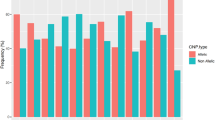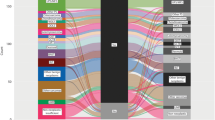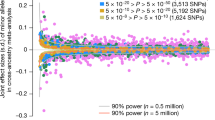Abstract
DNA variants in a 31-kb region of the human major histocompatibility complex, encompassing the tumor necrosis factor (TNF) gene cluster, were surveyed by direct sequencing of 283 unrelated individuals from six Chinese populations. A total of 273 polymorphic sites were identified, with nearly half of them novel. We observed an excess of rare variants and negative values of selection tests of the region, implying either that these populations experienced a historical expansion or that the surveyed region was subjected to natural selection. Different characteristics of the sequence variation in the six populations outline the genetic differentiation between Northern and Southern Chinese populations. The distributions of recombination rates are similar among all the populations, with variation in the magnitude and/or in the fine location of hot spots. Tag single-nucleotide polymorphisms (SNPs) selected from HapMap (Phase II) CHB data accounted for an average of 64% of common SNPs from the six Chinese populations. We also observed a limited transferability of tag SNPs between Chinese populations on the 31-kb region with an excess of untaggable SNPs and ragged linkage disequilibrium blocks. It suggested that the design and interpretation of future association studies should be more cautious, and that a resequencing approach may refine tag SNP selection on Chinese-specific disease mapping.
Similar content being viewed by others
Log in or create a free account to read this content
Gain free access to this article, as well as selected content from this journal and more on nature.com
or
References
International Human Genome Sequencing Consortium. Finishing the euchromatic sequence of the human genome. Nature 431, 931–945 (2004).
The International HapMap Consortium. The International HapMap Project. Nature 426, 789–796 (2003).
Lettre, G., Jackson, A. U., Gieger, C., Schumacher, F. R., Berndt, S. I., Sanna, S. et al. Identification of ten loci associated with height highlights new biological pathways in human growth. Nat. Genet. 40, 584–591 (2008).
Livingston, R. J., von Niederhausern, A., Jegga, A. G., Crawford, D. C., Carlson, C. S., Rieder, M. J. et al. Pattern of sequence variation across 213 environmental response genes. Genome Res. 14, 1821–1831 (2004).
Zhou, S. F., Liu, J. P. & Chowbay, B. Polymorphism of human cytochrome P450 enzymes and its clinical impact. Drug Metab. Rev. 41, 89–295 (2009).
He, Y., Jiang, R., Fu, W., Bergen, A. W., Swan, G. E. & Jin, L. Correlation of population parameters leading to power differences in association studies with population stratification. Ann. Hum. Genet. 72, 801–811 (2008).
McVean, G. A., Myers, S. R., Hunt, S., Deloukas, P., Bentley, D. R. & Donnelly, P. The fine-scale structure of recombination rate variation in the human genome. Science 304, 581–584 (2004).
Li, J., Zhang, M. Q. & Zhang, X. A new method for detecting human recombination hotspots and its applications to the HapMap ENCODE data. Am. J. Hum. Genet. 79, 628–639 (2006).
Barreiro, L. B., Laval, G., Quach, H., Patin, E. & Quintana-Murci, L. Natural selection has driven population differentiation in modern humans. Nat. Genet. 40, 340–345 (2008).
Zondervan, K. T. & Cardon, L. R. Designing candidate gene and genome-wide case-control association studies. Nat. Protoc. 2, 2492–2501 (2007).
Chanock, S. J., Manolio, T., Boehnke, M., Boerwinkle, E., Hunter, D. J., Thomas, G. et al. Replicating genotype-phenotype associations. Nature 447, 655–660 (2007).
The International HapMap Consortium. A second generation human haplotype map of over 3.1 million SNPs. Nature 449, 851–861 (2007).
de Bakker, P. I., Burtt, N. P., Graham, R. R., Guiducci, C., Yelensky, R., Drake, J. A. et al. Transferability of tag SNPs in genetic association studies in multiple populations. Nat. Genet. 38, 1298–1303 (2006).
de Bakker, P. I., Yelensky, R., Pe’er, I., Gabriel, S. B., Daly, M. J. & Altshuler, D. Efficiency and power in genetic association studies. Nat. Genet. 37, 1217–1223 (2005).
Teo, Y. Y., Small, K. S. & Kwiatkowski, D. P. Methodological challenges of genome-wide association analysis in Africa. Nat. Rev. 11, 149–160 (2010).
Clark, A. G., Hubisz, M. J., Bustamante, C. D., Williamson, S. H. & Nielsen, R. Ascertainment bias in studies of human genome-wide polymorphism. Genome Res. 15, 1496–1502 (2005).
Cavalli-Sforza, L. L. The Chinese human genome diversity project. Proc. Natl Acad. Sci. USA 95, 11501–11503 (1998).
Chu, J. Y., Huang, W., Kuang, S. Q., Wang, J. M., Xu, J. J., Chu, Z. T. et al. Genetic relationship of populations in China. Proc. Natl Acad. Sci. USA 95, 11763–11768 (1998).
Deng, W., Shi, B., He, X., Zhang, Z., Xu, J., Li, B. et al. Evolution and migration history of the Chinese population inferred from Chinese Y-chromosome evidence. J. Hum. Genet. 49, 339–348 (2004).
Ding, Y. C., Wooding, S., Harpending, H. C., Chi, H. C., Li, H. P., Fu, Y. X. et al. Population structure and history in East Asia. Proc. Natl Acad. Sci. USA 97, 14003–14006 (2000).
Jin, L. & Su, B. Natives or immigrants: modern human origin in East Asia. Nat. Rev. 1, 126–133 (2000).
Xue, Y., Zerjal, T., Bao, W., Zhu, S., Shu, Q., Xu, J. et al. Male demography in East Asia: a north-south contrast in human population expansion times. Genetics 172, 2431–2439 (2006).
Xue, F., Wang, Y., Xu, S., Zhang, F., Wen, B., Wu, X. et al. A spatial analysis of genetic structure of human populations in China reveals distinct difference between maternal and paternal lineages. Eur. J. Hum. Genet. 16, 705–717 (2008).
Librado, P. & Rozas, J. DnaSP v5: a software for comprehensive analysis of DNA polymorphism data. Bioinformatics (Oxford, England) 25, 1451–1452 (2009).
Tamura, K., Dudley, J., Nei, M. & Kumar, S. MEGA4: Molecular Evolutionary Genetics Analysis (MEGA) software version 4.0. Mol. Biol. Evol. 24, 1596–1599 (2007).
Excoffier, L., Laval, G. & Schneider, S. Arlequin (version 3.0): an integrated software package for population genetics data analysis. Evol. Bioinform Online 1, 47–50 (2005).
Ramos-Onsins, S. E. & Rozas, J. Statistical properties of new neutrality tests against population growth. Mol. Biol. Evol. 19, 2092–2100 (2002).
Stephens, M. & Scheet, P. Accounting for decay of linkage disequilibrium in haplotype inference and missing-data imputation. Am. J. Hum. Genet. 76, 449–462 (2005).
Li, J. Z., Absher, D. M., Tang, H., Southwick, A. M., Casto, A. M., Ramachandran, S. et al. Worldwide human relationships inferred from genome-wide patterns of variation. Science 319, 1100–1104 (2008).
Barrett, J. C., Fry, B., Maller, J. & Daly, M. J. Haploview: analysis and visualization of LD and haplotype maps. Bioinformatics (Oxford, England) 21, 263–265 (2005).
Biswas, S. & Akey, J. M. Genomic insights into positive selection. Trends Genet. 22, 437–446 (2006).
The International HapMap Consortium. A haplotype map of the human genome. Nature 437, 1299–1320 (2005).
Yao, Y. G., Kong, Q. P., Bandelt, H. J., Kivisild, T. & Zhang, Y. P. Phylogeographic differentiation of mitochondrial DNA in Han Chinese. Am. J. Hum. Genet. 70, 635–651 (2002).
Wen, B., Li, H., Lu, D., Song, X., Zhang, F., He, Y. et al. Genetic evidence supports demic diffusion of Han culture. Nature 431, 302–305 (2004).
Deakin, J. E., Papenfuss, A. T., Belov, K., Cross, J. G., Coggill, P., Palmer, S. et al. Evolution and comparative analysis of the MHC Class III inflammatory region. BMC Genomics 7, 281 (2006).
Skoog, T., van’t Hooft, F. M., Kallin, B., Jovinge, S., Boquist, S., Nilsson, J. et al. A common functional polymorphism (C → A substitution at position −863) in the promoter region of the tumour necrosis factor-alpha (TNF-alpha) gene associated with reduced circulating levels of TNF-alpha. Hum. Mol. Genet. 8, 1443–1449 (1999).
Bamshad, M. & Wooding, S. P. Signatures of natural selection in the human genome. Nat. Rev. 4, 99–111 (2003).
Li, D. N., Ying, D. J. & Ou, C. Y. Establishment and preservation of immortal lymphoblastoid cell lines of the Ha-LI, the QI-LI and the Bendi-LI ethnic groups in Hainnan Island, China. Hai Nan Yi Xue Yuan Xue Bao 10, 6–8 (2004).
Lin, S. Q. The History of resistance of Malaria in Hainan Island. Hainan Med. J. 2, 70–72 (1986).
Verrelli, B. C., McDonald, J. H., Argyropoulos, G., Destro-Bisol, G., Froment, A., Drousiotou, A. et al. Evidence for balancing selection from nucleotide sequence analyses of human G6PD. Am. J. Hum. Genet. 71, 1112–1128 (2002).
Timmann, C., Evans, J. A., Konig, I. R., Kleensang, A., Ruschendorf, F., Lenzen, J. et al. Genome-wide linkage analysis of malaria infection intensity and mild disease. PLoS Genet. 3, e48 (2007).
Hill, A. V. The immunogenetics of resistance to malaria. Proc. Assoc. Am. Physicians 111, 272–277 (1999).
Zhou, D. F., Wang, Z. & Cai, L. J. Investigation into the deletion types of alpha-thalassemia in Han and LI Nationalities in Hainan Province. CHINA Trop. Med. 6, 1549–1551 (2006).
McGuire, W., Hill, A. V., Allsopp, C. E., Greenwood, B. M. & Kwiatkowski, D. Variation in the TNF-alpha promoter region associated with susceptibility to cerebral malaria. Nature 371, 508–510 (1994).
Flori, L., Delahaye, N. F., Iraqi, F. A., Hernandez-Valladares, M., Fumoux, F. & Rihet, P. TNF as a malaria candidate gene: polymorphism-screening and family-based association analysis of mild malaria attack and parasitemia in Burkina Faso. Genes Immun. 6, 472–480 (2005).
Coop, G., Wen, X., Ober, C., Pritchard, J. K. & Przeworski, M. High-resolution mapping of crossovers reveals extensive variation in fine-scale recombination patterns among humans. Science 319, 1395–1398 (2008).
Myers, S., Bottolo, L., Freeman, C., McVean, G. & Donnelly, P. A fine-scale map of recombination rates and hotspots across the human genome. Science 310, 321–324 (2005).
Myers, S., Freeman, C., Auton, A., Donnelly, P. & McVean, G. A common sequence motif associated with recombination hot spots and genome instability in humans. Nat. Genet. 40, 1124–1129 (2008).
Evans, D. M. & Cardon, L. R. A comparison of linkage disequilibrium patterns and estimated population recombination rates across multiple populations. Am. J. Hum. Genet. 76, 681–687 (2005).
Gonzalez-Neira, A., Ke, X., Lao, O., Calafell, F., Navarro, A., Comas, D. et al. The portability of tagSNPs across populations: a worldwide survey. Genome Res. 16, 323–330 (2006).
Service, S., Sabatti, C. & Freimer, N. Tag SNPs chosen from HapMap perform well in several population isolates. Genet. Epidemiol. 31, 189–194 (2007).
Bhangale, T. R., Rieder, M. J. & Nickerson, D. A. Estimating coverage and power for genetic association studies using near-complete variation data. Nat. Genet. 40, 841–843 (2008).
Xu, Z., Kaplan, N. L. & Taylor, J. A. Tag SNP selection for candidate gene association studies using HapMap and gene resequencing data. Eur. J. Hum. Genet. 15, 1063–1070 (2007).
Need, A. C. & Goldstein, D. B. Genome-wide tagging for everyone. Nat. Genet. 38, 1227–1228 (2006).
Marchini, J., Howie, B., Myers, S., McVean, G. & Donnelly, P. A new multipoint method for genome-wide association studies by imputation of genotypes. Nat. Genet. 39, 906–913 (2007).
Acknowledgements
This work was supported by National Science Foundation of China Grants 30470946 (Professor Wang) and by China Medical Board, CMB 04-805, CHINESE GENOMIC DIVERSITY (Professor Chu).
Author information
Authors and Affiliations
Corresponding authors
Ethics declarations
Competing interests
The authors declare no conflict of interest.
Additional information
Supplementary Information accompanies the paper on Journal of Human Genetics website
Supplementary information
Rights and permissions
About this article
Cite this article
Zhang, Y., Zhang, F., Lin, H. et al. Nucleotide polymorphism of the TNF gene cluster in six Chinese populations. J Hum Genet 55, 350–357 (2010). https://doi.org/10.1038/jhg.2010.33
Received:
Revised:
Accepted:
Published:
Issue date:
DOI: https://doi.org/10.1038/jhg.2010.33



